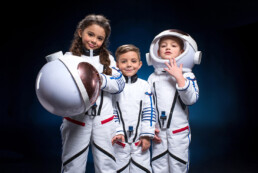How VR is changing storytelling
3D Culture: a new perspective of life
Three-dimensional experiences can be traced to the early 1900s, experimenting with 3D-filmmaking. Around the same time, the concept of “Culture” as we know it now, started to shape up. Both disciplines were trying to create a vivid representation of an object, a situation or behavior in order to understand it. Scientists use mathematics or physics, while anthropologists use social concepts. More than 100 years passed already and we still trying to figure things out.
Virtual reality, 3D experiences, and three-dimensional selfies are part of the normal, so it’s organic to think about culture in a three-dimensional way, or what I like to call, 3D Culture. Borrowing from concepts from 3D modeling, we could say that it’s possible to create a model of an object (situation/moment). We should be talking about a “multiverse” approach, but let’s move in little steps. I worked plenty with 3D artists, XD designers and collaborated with researchers and analysts on multicultural projects, so inadvertently I became a 3D Cultural Analyst, rendering situations into models, creating a mental sculpture to have a 360 understanding. We model culture using our own algorithms (thoughts and perceptions) shape and texture our objects (experiences) and look at it from many angles (situations). Don’t worry if this doesn’t make sense, keep reading, we are almost there.

Our brain is an organic 3D living scanner, we collect information and data from many sources. We model situations, ideas, actions and behaviours based on new input and within our own archives and mental 3D library of emotions, thoughts, memories, sounds, smells and flavors. We give this objects meaning through texture mapping and create high poly experiences. The result is a beautiful, amazing 3D model of who we are and how we see the world. All in real-time.
This mentally interactive, three-dimensional cultural model reflects and shapes our story and how we behave, on a daily basis. Our ideas, thoughts and beliefs, even the music we listen, the food we like or the books we read are part of our 3D cultural model, shaping our identity and framework to our ‘why we do things the way we do’. And it’s passed down from one generation to the next one.
Culture is wide and filled with many layers, and naturally we tend to simplify things pre-modeled objects, royalty free-ideas of what something means. Words come with a significant amount of conceptual baggage. For example, think of the word “Argentina”. Did your mind conjured images of tango, gauchos and delicious steak?…and what about California…Hollywood and golden beaches? or India (colorful dances, spicy food and Ganesha). Or in reverse, the words ‘fiesta’, ‘nachos’ and ‘5 de mayo’ in a single phrase invoques the idea of Mexico. So wrong on many levels. The reality is that words convey powerful notions of “Argentinean” or “Indian” qualities. How people dress and eat is just part of it, and really a very small indicator of all the symbols, traits, diversity and depth that each amazing and unique culture. Also, culture exists beyond its ‘Wikipedia’ country description. Office buildings, universities, shopping markets, public transportation, coffee shops, anywhere people interact and share the same language, slang, interests and values creates culture: a subculture. They can be united by a music style, a game or a concept, food or sports, uniting complete strangers from around the globed, with opposite cultural into a single hearted vision.

Spoiler Alert! you can’t design for everyone.
But we can focus on a subculture and inspire culture from the inside-out, enabling ambassadors. This shift build space for growth, mixing innovation and design with relevant insights into the deeper layers of cultural behavior. Its an opportunity reinvent and a vibrant playground for talent to make better products and services.
People are people no matter which country you are, and you’ll find interests and tastes as diverse as their inhabitants. From gender identification, tradition, decision-making process and concepts of self. We could try to isolate subcultures using this parameters. Spoiler Alert! you can’t design for a whole culture. Appealing to everyone is a waist of resources and time. What we can is to focus on a subculture, inspiring culture from the inside-out as ambassadors. Become and real influencer. A 3D cultural approach allows us to take a fresh look into situations from various directions and views -like a 3D camera moving around a virtual scenario-. so we can identify opportunities and challenges and had a quick understanding without investing much time.
Subcultures thrive within culture and sharing similar values, beliefs or behaviors, but “updated” to reflect their current life experience. Happens a lot with expats for example, were we adapt our ‘mother-culture’ re-significating to continue cultural survival and cultural evolution. “Tex-Mex”, “Chinese-American” “Techno-Jazz” “Newyorican” are everyday simple examples. You can be Argentinian, speak spanish at home, polish with friends, and english at work Italian father and Argentine mother, raised in Buenos Aires, lived in the US half your life and living in Poland. That’s my crazy 3D cultural model.
3D cultural models are a multi-method approach using traditional tools, ethnographic observation, media investigation, data research, social behaviours and sub-cultural pointers to create a playground to analyse key and relevant findings. highlighted by cultural heritage, geographic momentum and social influences to generate a valuable framework to capitalise cultural-data opening new avenues for further research under the cultural-technological evolution umbrella. 3D cultural modelling gives flexibility to change angles quicker without re-formulating the scene, can easily help us calculate effects and behaviours, and get a subculture estimate with a 360 experience perception. This is not overriding classic techniques but a supportive framework to play with those variables, a view of the world through multiple lenses, from the individual to the collective, creating a storytelling that empowers, encourages and represents people transcending time, culture and language, and finally understanding that diversity is the one true thing we have in common.
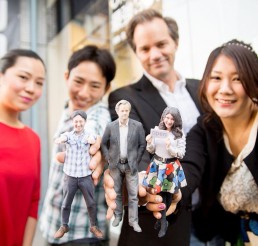
Transforming kids content playground
The game-changer: deliver knowledge
From Tiktok to YouTube, younger generations are influenced by a diet of digital content at a very early age. Media companies are focusing to understand what kind of content is more attractive to this ‘Generation Z’. Getting an accurate track is challenging since the majority of content is consumed on smartphones, tablets, and game console devices that still are not included in the ratings. Besides guessing what content is ‘popular’ or successful, there’s also ad revenue decline. The question is how this will reflect on subscribers, new users, and customers in the long run.
Delivering innovation, and not as a buzzword, is more than tech, apps, or new marketing: is a mindset, on how we approach business and content. As a creative and designer, successful business is how can brands relate with audiences, but going a step forward in how we deliver knowledge. This is the real game-changer.
Educational content, the key to the future
Operators generally target families, becoming key drivers of on-demand offerings. Netflix is one of the largest providers of online children’s content through output agreements, but they produced (or acquired) their own content since Disney+ launched its powerhouse streaming, the same with HBOMax feeding from Cartoon Network lineup. Amazon and Discovery, same story. How can we keep up -and more important- be at the top of the game? One approach is to create a market, understand the market, and leverage products and services to its needs. More than revolutionary, it’s smart. The Danish family-owned business LEGO is a fantastic business example, from associating movie franchises and IP’s with its pint-sized heroes, games, movies, etc, to launching major educational programs and learning products in China, the US, and Europe. We need a LEGO Channel asap.
Inspiring children through creative play and learning
It’s not just about having fun, but also delivering purposeful, problem-solving narrative entertainment. Educators, artists, science experts, and creators need to assemble and inspire the next generation, now. This is one of the main drivers growing both business and quality for kids’ content and media.
A decade ago, The Jim Henson Company created Sid the Science Kid (2008), dedicated to teaching science to preschoolers. PBS and other networks saw the genius in the idea. Today, STEAM programs are a must in every serious school program, even popular programming for kids from three to thirteen relate to this. Fun and great STEAM programming have created a diverse and exciting universe of content to stimulate young imaginations and make all kids feel like they can play at being an inventor, engineer, scientist, or artist.
LEGO® Education SPIKE™ Prime student classes enable kids to develop stronger critical thinking and problem-solving skills
Educational entertainment: a bright future
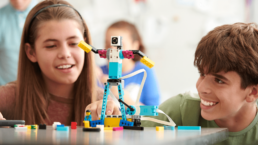
Companies are in creating a new slate of children’s and YA content. Roku, Apple TV, Android TV, and Chromecast join the ranks of Netflix (MC2/Magic School Bus), Amazon (Annedroids/Creative Galaxy/Tumble Leaf), PBS (Sci Girls/Sid the Science Kid/DinoTrain), and Marvel TV with kids’ specific educational content aimed to engage fans building audience strategies for years to come. From integrated educational programs and award-winning content, companies created a whole series of solutions for younger students and help teachers to leverage and engage with their students. We need educational evolution to avoid mental extinction.
Streaming content like “Doozers” (Hulu), focus on “design teaching” based on engineering and design, fantastic machines using recycled resources. Playing creates a perfect opportunity for kids (and adults) to become active, collaborative learners and have fun. Annedroids (Amazon) Its also very much connected to STEAM curricula. Kid-scientist Anne has invented and built her own amazing androids in her backyard lab and enlisted the help of other kids in the neighborhood.
Xbox, more than games
Even Xbox users already spend more time watching video than playing games with the device and heavyweights like Nickelodeon, Hulu and Dailymotion are partnering to create another avenue to connect with their audiences. Tiktok is pushing to bring premium content and live streaming services to sell advertising packages, and even Disney and Saban invested in a viral content platform “Playbuzz” to create and distribute content into social media outlets.
Also, the NFL and the MLB are going after young audiences, encouraging their stars to reach out to fans via Twitter, Instagram, and Snapchat. The focus is to motivate youngsters who are not watching football or baseball on TV (but spending hours on digital) to watch streaming matches online and on mobile. NBCU made a savvy move announcing a consolidated upfront selling advertising across platforms and marketers are targeting interrelated audiences.

Xbox delivers a solid interface featuring all entertainment in one place, from games to favorite streaming, apps and the latest movies.
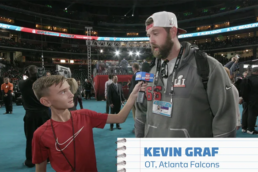
Sports Illustrated Kids interviews Patriots and Falcons at Super Bowl LI media day in Houston.
These initiatives serve both content and business. The result is much more efficient kids content, generating deeper engagement, and building revenue streams outside the traditional media universe.
Today is the streaming revolution, tomorrow maybe be something else, but innovation will always be the constant. Is the ability to transform the business and identify what plays the best. A thought from Viktor Frankl comes to my mind: “When we are no longer able to change a situation, we are challenged to change ourselves”.
Creating tomorrow for the next generation
What kind of resources are we providing today so the next generation can make the right decisions, develop leading skills and choose the right opportunities for them in a world overloaded with choices and information. The key starts with the right mindset and the best set of tools, both intellectual and emotional. Let's dive in...
Recalculating your thoughts
We value intelligence, personality, and character. But what is it? Luck, chance, genetic predisposition? Some believe success is based on natural abilities, others, on learning those abilities, or even the circumstances you were born. But identity and how we define ourselves are the building blocks of our future. This can change everything. What we ‘think’ of ourselves is who we think we are, and our conscious and unconscious thoughts affect our decisions, especially at work, in our careers, and in the direction of our future. Doesn’t matter if you are 7 or 47, those beliefs and mindsets will guide your steps.
We all have different situations, but those conditions are not set or final, they are a starting point. And that’s where your ‘mindset’ comes in handy. What we think and believe of ourselves is what’s happening: where you are right now is a result of that.
Changing your beliefs can have a powerful impact on your mindset. Imagine if you could “recalculate” our destination, and how we relate to others, and make decisions -career or personal ones-. Commonly, a “mindset” is associated with entrepreneurs. And that’s correct, but it’s just the tip of the iceberg. Learning, overcoming, trying. Imagine what would happen if you think of failure as a learning opportunity?
Our focus should be on inspiring kids to develop their own abilities, confidence, and possibilities so they can find their own mission, understand value, and whatever success means for them. And even in the most adverse conditions or failures, kids (and adults) will be able to find their way and purpose.
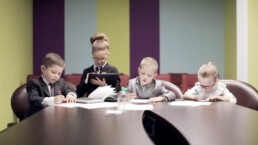
More than skill, its a vision
Building a mindset is more related to ‘purpose’ than to a set of skills. Mindset is simply a belief system. It’s an attitude, disposition or tendency that a person adopts to respond to challenges, tasks, and opportunities. An entrepreneurial attitude is at its core level, resolving a problem by working out a solution. A mind is inspired by belief, that inspires others. Confident and positive, creative, resourceful, and resilient, capable of distilling concepts and ideas into actions and decisions, generating momentum and an atmosphere for things to happen. An entrepreneurial mindset goes beyond creating a business or a start-up, an entrepreneurial person is someone who terraforms their environment, decisions, and actions into creating its own future and drives cultural changes, from one family to an entire nation, to one succesful product to a lifestyle revolution.

Learned skills or natural traits?
Some people look at change and see opportunity, others look at problems and see solutions. Why is that? Some, when challenged, rise above, while others paralyze by doubts and indecision. Although we are all born with a specific set of genes, with no control over our genetic allocation, we know lifestyle choices and different experiences through development and maturity can influence gene expression and thus exert influences over behavior.
Everyday experiences instill the “entrepreneurial” mindset, beginning within our family, and later when we go to school, college, the friends we have, and finally at the workplace. The sooner you start to understand and use these traits, it becomes a habit.
While entrepreneurship skills can be learned, and become a successful business entrepreneur, a classroom environment has its limits. Inspiring a mindset is a hands-on process, especially when you focus on leadership (and team development). Entrepreneurial instincts are naturally incorporated at home, by family members or observing other people, even friends. They may not use MBA or Masters terms, but they do understand the actions that matter to achieve success. And it focuses not only on their personal success but on helping others to reach their success.
Where do we start?
The first step is to do a bit of “spring cleaning’, let some fresh air into the mind. Take a moment to look at your ‘mindset’ and visualize it. Are you aware of your abilities? how do you perceive your value? What do you love to do (having an ice-cream sandwich doesn’t count… unless you are planning to develop an Ice cream empire, you see, a passion can become a skill). Normally we connect the term “successful mindset” with entrepreneurs, but there’s so much more.
Strengthen confidence and trust in your abilities will boost your decision-making skills, your learning skills, and your time management. Imagine having more time to improve something you like or do something completely new. The simplest change in your mindset can have a profound impact on every aspect of your life. Imagine if you could “recalculate” your direction? From the way relate to others, the way you make decisions, career or romantic ones.
Practical application: if you feel brave enough, write down a list of your skills -even if it sounds small or unimportant- You might discover hidden or untapped skills. Write also what you are good at, and what you’ll like to improve. Also, exercise looking around. Focus on small situations and things that are important to you. Successful moments, mistakes…what is worthy to repeat and what to do differently. Understanding the value you could bring to your situation is the springboard to your future. Even if is a small thing, the payoff is giant. It will literally change the course of your actions. Learning, overcoming, expanding your tent. Imagine what would happen if you think of failure as a learning opportunity? or an obstacle as a chance for developing skills. The sky is the limit.
Creating an entrepreneurial mindset means inspiring people to believe in themselves and to dream big about what their future could be. It’s guiding people, teams and organizations to see the potential in ideas and situations, both individually or part of a group or community. Its creating a future.

Transforming Anxiety into Creative Energy
Fast-paced enviroment, calendars max-out with meetings, full inbox, and 4pm calls leave us with very little time for strategic activities. Even the best jobs and the best teams experience this pressure in one form or another. The harder you work and the more motivated you are to succeed, the easier we feel we have no time to accomplish what is important to us and also to the organization advance. A week goes too fast and too furious.
Time constraints can get the better of you, and this anxiety bleeds over into how we interact with people. We want to inspire our team, but we literally don’t have the time. How can we find the precious balance, be a good leader and still get things done? The answer maybe a bit hidden in between of meetings and dayly routine.
Small moments, big opportunities
Every day is a combination of smaller moments. So if we take those moments apart, into smaller, more manageable situations we can make more sense of our busy schedule. With this deconstruction process we can take any situation apart and then assemble it back together in new and unexpected ways (my partner specializes in fashion pattern deconstruction and was the inspiration for this idea). Elements on a situation may have been intermingled and the way you deal with one will impact on other parts of the problem.
How we use the small moments and brief interaction in our day? Small gestures and invisible situations can bring out the best leadership inspiration. We cannot fix everything, but we can make a difference. It makes me think of the small pebble creating big ripples in the water. I dont think even the pebble knows what is creating behind. Leading and inspiring is something you get better with practice and its done in step by step.
The first thing is to identify what these small moments in our everyday conversations and interactions at work, and even at home. We are too busy to take time but with little attention you’ll see them very clear as Neo sees the ‘Matrix’. You can seize a small moment into a learning opportunity.
Finding the ‘smaller parts’ can be a challenge, but once you identify this, everything becomes much easier and more productive.

Making space in our busy schedule is a challenge, but this terraforming creates an opportunity to growt and a vibrant playground for talent to make better products and services. Creativity is an energy and whether you realize it or not, you emit and receive energy. We have an electromagnetic field in which creative energy flows naturally, but when the polarity is disrupted our team creative energy system is affected. Is vital to pay attention, because is subtle but escalate quickly.
Become a power converter that change anxiety into creative energy
One of our focus, besides deadlines, meetings and product development is to motivate team members to grow, encourage intelligent dialogue, infuse confidence, and empowering the reach their best of their skills.Everything we do is fueled by it and foster creative energy is vital to the team and the work.
Find quick opportunities to grow a creative playground
-
Don’t try to solve the problem, listen first.
-
Create a space for dialogue and growth.
-
Give specific, constructive feedback.
-
Take time to know people.

Don’t try to solve the problem…first listen: When someone comes to you for help, we rush giving people suggestions when they ask for help. Ask them what they think would be a good solution and then create a space to implement it or try it out. By this, the team member can develop ownership of the solution, as they learn how to seize the opportunity and make a change.
Create space for dialogue and growth: People are afraid to admit a mistake because of the consequences, understandable. But when someone comes and says, “I think I made a mistake.” Don’t jump at it with all your artillery. Create an environment for growth and show them you trust them, even when there’s a mistake in the middle. We all make mistakes, remember. Think about the time you screwed-up and how you’d liked to be treated. This is a critical moment, especially in the process of innovation where failure is essential to the exploration process.
Give specific, constructive feedback: Concentrate on positive and specific suggestions on the situation and behavior. Not the person. Kindness and accuracy are important. Finally, what was the impact of the conflict or situation? Feedback is not criticism or praise, it is about observation. It’s timely and specific. It describes but doesn’t judge, and brings an understanding of the situation or issue. It’s one of the simplest yet most effective ways to develop others, creating a pattern of learning and growth.
Take time to know people: teams are made of people, personalities and attitudes. Recognize the diffences and look for ways to connect similar interest. A quick ”How are you, how’s everything? can open up a dialogue. Kindness is never out of fashion, and a bit of empathy can overcome frustrations and give you understanding on and how to offer support. It’s about build connections to inspire growth. Especially with creative teams, artists, designers, developers, well…everyone. Strive for authenticity, not perfection. Remember that conversation is with people, not to people.

Educación en tiempos de Pandemia
Educación Digital: desafio o evolucion?
CoVid19 cambio definitivamente las estructuras educativas. Escuela y hogar (y tambien trabajo), se ha transformado en un mismo lugar. Según la UNESCO, más de 861.7 millones de niños y jóvenes en 119 países se han visto afectados al tener que hacer frente a la pandemia global que nos ha sacudido este año. Millones de familias en EE.UU. forman parte del 1.7 millón de niños que hacen educación en el hogar (homeschooling). Y el debate politico y social respecto a la seguridad de enviar a los niños a clase, todavia sigue siendo un tema de polémica. Especialmente en America Latina e India donde la pandemia esta en su momento mas critico.
Cambiando la mentalidad del aula: Los nuevos métodos y profesionales de la educación.
La innovación en materia de tecnología educativa han impactado en cómo los alumnos y profesionales quieren aprender. Aulas virtuales, dispositivos móviles, lectores digitales, VOD, video games y contenidos en “la nube” alimentan a un mercado ‘hambriento’ de innovación.
Un factor clave para la innovación es la tasa de adopción de nuevas tecnologías por parte de la comunidad joven. Los millennials que buscan insertarse en el mercado laboral, traen un conjunto de expectativas acerca de cómo aprender y colaborar. Más aún, ellos nos enseñan que el aprendizaje se logra mejor en incrementos continuos, en función de la demanda/necesidad de aprendizaje y capacitación de los alumnos.
Gracias a la evolución de la tecnología y la aparición de múltiples dispositivos y diversos medios de comunicación, una de las claves para hacer que el aprendizaje sea eficiente y eficaz es la velocidad, disponibilidad y accesibilidad de los contenidos. Los empresarios y compañías reconocen la oportunidad de aprovechar el mercado de educación “adulto”, no solo aumentando la inversión en estos productos sino también en el desarrollo de contenidos y experiencias de aprendizaje “on-demand”.
Esta tendencia no es una moda a corto plazo, relacionada con una plataforma de moda, sino más bien, un cambio de paradigma que tendrán un impacto profundo en el mercado del futuro.
La inversión en tecnologías educativas acompaña la capacidad y necesidad del alumno de consumir contenido rápido, cuándo quiere y donde quiera. Herramientas para desarrollo y capacitación, entrega de contenidos, lectores digitales, bibliotecas virtuales, juegos y sistemas de administración basados en la nube han impulsado un alto nivel de innovación educativa.
Gran parte de la inversión proviene de empresas que tradicionalmente han invertido educación post-secundaria, pero ahora están cambiando su enfoque hacia la capacitación laboral. La razón principal de este cambio está directamente ligada a la manera de consumir contenidos, ya que la capacidad y accesibilidad de contenidos y conocimientos trasciende los niveles de edad, alcanzando el mercado de la educación de adultos y la formación corporativa.
ESTUDIANTES EN LAS NUBES.
con la llegada de los dispositivos móviles y la modalidad de contenidos por demanda, las bibliotecas virtuales han crecido rápidamente. Este rápido crecimiento significa que los alumnos tienen acceso a prácticamente cualquier tipo de contenido de aprendizaje que deseen en cualquier momento que quieran -y en cualquier dispositivo- ya sea un celular o una tablet, y no están más limitados a una computadora de escritorio o un aula física. La abundancia de información puede ser algo positivo para los estudiantes, pero en el caso de la capacitación profesionales debe tener una estrategia que garantice a los alumnos un contenido diseñado especialmente para sus necesidades de trabajo y objetivos de capacitación.
PERSONALIZAR LA EXPERIENCIA DE APRENDIZAJE.
Aprendizaje adaptativo es acerca de la personalización de la experiencia de aprendizaje. Mediante el uso de técnicas de aprendizaje adaptativas, podemos reducir el tiempo que toma a los alumnos para que dominen, eliminando la necesidad de cubrir contenidos obsoletos o ya conocidos. Esto mejora la efectividad de los programas, ya que el alumno sólo se centra en lo que es necesario.
Los enfoques tradicionales de desarrollo de contenidos se focalizan en un ‘talle unico’ en vez de adaptar el contenido a las necesidades del alumno. La experiencia de capacitación busca la personalización del contenido, pero para ello, la plataforma debe poder replicar esta experiencia ajustando la información en base a elecciones o respuestas anteriores del alumno. El éxito futuro de aprendizaje adaptativo es no está sólo en el diseño de la tecnología, sino en el diseño del contenido. El contenido debe ser acortado y modificado en los objetos de aprendizaje, consumida según las necesidades del alumno.
LA EXPERIENCIA DE APRENDIZAJE: MENTORÍAS
La ciencia del aprendizaje nos ha revela que una de las técnicas más eficaces para aumentar la retención y la aplicación de un contenido es ampliando la experiencia de aprendizaje a pre y post-capacitación. El lugar de estudio y trabajo sigue evolucionando con la aparición de nuevas generaciones y nuevas tecnologías, desarrollando una cultura de aprendizaje más inclusiva.
Las empresas valoran el desarrollo interno de líderes para el futuro, y el conocimiento institucional se transmite a nuevos talentos. Una de las maneras más eficaces para transferir conocimiento propio es a través de mentoring y coaching. Y el viejo dicho es cierto, la mejor manera de aprender algo nuevo es enseñándolo. La tutoría no sólo desarrolla los alumnos, sino que también es una forma de desarrollar talento actual del que enseña.
Change the color to match your brand or vision, add your logo, choose the perfect layout, modify menu settings and more.
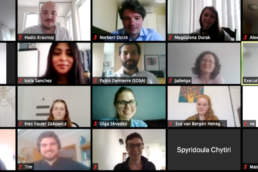
EVOLUCIÓN DE LAS MECÁNICAS DE JUEGO
Enseñanza a través de medrosos lúdicos mejora la motivación, el compromiso y la retención de conocimientos. La pronta ejecución de los juegos se centró en la sustitución de la experiencia en el aula con un juego. El siguiente paso evolutivo en el mundo de los videojuegos nos permitió aprender a incorporar mecánicas de juego en programas de aprendizaje. El corazón un juego atractivo (video-games) es una buena historia que atrae a los jugadores, apelando a sus motivaciones y emociones. La evolución de la teoría de juegos ha encontrado que utilizando el principio de la narración y la participación conecta las emociones del alumno mientras aumenta su participación y asimilación.
CLASES PEQUEÑAS, GRANDES RESULTADOS.
Con la popularidad de las plataformas virtuales y programas de formación en línea los modelos de aulas tradicionales van evolucionando. La razón de una clase con muchos alumnos era para amortizar los costos fijos asociados con un instructor y el aula. Ahora las necesidades del negocio y las necesidades de los alumnos están alineadas. La formación de profesionales está conectada directamente con las necesidades del mercado laboral, y con la comprensión de esta necesidad, podemos mejorar el rendimiento académico del alumno.El desafío es poder desarrollar contenidos que se adapten a las necesidades del alumno.
La experiencia educativa necesita prepararse para el futuro del aprendizaje, quizás no sabemos cuál será la tecnología de aquí a un par de años, quizás sea una tableta holografía de VR, no lo se. Pero el futuro está en conectado con la experiencia colaborativa y social. Las escuelas del futuro quizas tengan clases online con estudiantes ubicados en diferentes o incluso diferentes países. La tecnología no debe ser una barrera para la enseñanza, o reducida a un dispositivo o una plataforma, sino como un viaje cambio, crecimiento y evolución social.
Using VR in Hospital Treatments
Virtual Reality to Reduce Pain for Hospitalized Children
The VR technology enables pediatricians at children’s hospitals and healthcare facilities in the US to use the headsets as a procedural tool for critically ill young patients, primarily to reduce anxiety during mild to moderately painful procedures. By using VR as a calming distraction, several patients have been able to undergo these procedures whilst awake, cutting down lengthy recovery times, and reducing the need for medication. Lenovo Collaboration with Starlight Children’s Foundation® Shows how technology and hope can positively impact kids’ health to alleviate pain for young patients.
By using VR as a calming distraction, several patients have been able to undergo these procedures whilst awake, cutting down lengthy recovery times, and reducing the need for medication.
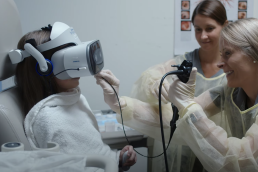
Improving the quality of life of hospitalized children
“Due to the distressing nature of treatments such as a lumbar puncture, where a needle is used to withdraw spinal fluid and sometimes administer medication, our patients often receive the procedure under general anesthetic. Virtual Reality can be used in place of general anesthesia to help tolerate pain, and in fact, it is having a profound impact on the quality of life of our hospitalized children. We are seeing children who used to require general anesthesia, now able to be fully awake with minimal medications.” Joe Albietz, MD, Medical Director at Child Life, Children’s Hospital Colorado
Digital Approach of Mental health during COVID-19
Since the pandemic started, social interactions have been limited, with authorities setting the maximum number of people in a group, in some cases imposing curfews. This all means that young individuals are subject to an increased risk of anxiety, social withdrawal, loneliness. Support groups and face-to-face services have been canceled, and many patients experienced relapses in mental conditions due to disruptions in school routines, which may serve as coping mechanisms. Children and adolescents have engaged with digital technologies so in many ways virtual reality therapy could be integrated to treat current mental health-related issues mentioned above.

Immersive VR to support mental health treatment
Virtual Reality therapy to treat anxiety, phobias, depression, stress, PTSD, and several mental health-related traumas. VR exposure therapy provides the opportunity for mental health professionals to not only reproduce real-life scenarios but also to adapt and control these environments to suit patients’ needs. This technology approach allows mental health professionals to evaluate, identify, and apply intervention protocols on patients’ fears and anxieties, in some cases showing quicker improvements, increasing the commitment to the therapy.
Watch the Stories
Programs that aim to integrate VR with traditional therapy techniques, improve the quality of hospitalized children and help with trauma.
A guide to raise entrepreneurial kids (Part 1)
To be at the top of the game, an entrepreneur requires creativity, empathy, communication skills, problem-solving ability, practical maths, and a knack for spotting something at the right moment and having the confidence to act. These key traits of entrepreneurs like presenting an idea, handle objections, or guide someone through tough decisions have their origin in the early stages of development and can be found at home or school in everyday activities. Let’s take a quick look:
1.Developing basic skills
To be at the top of the game, an entrepreneur requires creativity, empathy, communication skills, problem-solving ability, practical maths, and a knack for spotting opportunities at the right moment, and the confidence to act. These key traits of entrepreneurs have their origin in the early stages of a kid’s life and can be found at home or school in everyday activities. Although these kinds of skills -presenting ideas, handle objections, or guide someone through tough decisions- are often associated with entrepreneurs, are in fact the basic set of skills for kids that grow up ready to take on the world, ultimately steering them towards the right opportunity. Kids that develop the passion, the attitude, the skills to spot opportunities, resilience, faith, not afraid of critics and failures, are prepared to handle whatever life throws their way.
Starting at home: There are so many activities and fun things for kids to Inspire and nurture these skills. From negotiating what’s for dinner, or making decisions about planning the week, putting someone in charge of a task or a special event at home, like planning a Bday party.

2.Home-made skills
Raising kids with an awareness of entrepreneurship and its core skills can change their life for the better. Kids don’t need to actually be running a business, employing people, or pitching ideas to investors to gain these skills. Being a kid is already a serious business for them, so learning these skills should be fun and lighthearted. Kids are already practicing these skills at home at one point or another: pitching, negotiating, decision making, leadership, customer service, and creative thinking.
Practical examples: there are so many activities and fun things for kids to Inspire and nurture these skills. From negotiating what’s for dinner, or making decisions about planning the week, putting someone in charge of a task or a special event at home, like planning a Bday party. Challenges can be really fun and character-building.
Encouraging healthy debate about ways to help people or coming up with ideas to solve a problem so they can create their own framework for decision-making. Simple ideas that are fun, entrepreneurial and valuable. The earlier someone learns these skills the more second nature they will be in the future.
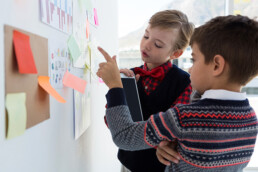
3. Opportunities are everywhere
Finding entrepreneurial opportunities involves playing and observing real-life situations. Allowing kids to experience and interact with real-life entrepreneurial scenarios will open their eyes to the possibilities. Not only in opportunities but also different people with different skills. Being open to opportunities means seeing the possibility and abundance of options and results, incorporating the notion that opportunities are everywhere, they just have to be found like a treasure hunt.
Great entrepreneurs look at problems and see solutions and disruption it’s only a chance to add value. They constantly think of new ideas for products, services and new businesses. Their brains become trained to seek out opportunities, working their idea muscles every day until eventually, success becomes real. Inspiring kids into an opportunity-seeing mindset involves thinking in that way yourself.
Foster questions that make kids think and observe their own paths and actions, opening playfully to the idea of “Why not” or “What if” Bring entrepreneurial opportunities closer by talking about their everyday activities and connect them to businesses or professions around them. Ask how they do, and how they do it, and which problems they encounter. Understanding the needs of the businesses all around you helps kids to become aware of possibilities, sparking ideas they could get involved in.
Practical example: observe situations around your home, neighborhood, or even current events that present a problem and need a solution, and bring up what could be done to solve the problem and “how could you be part of the solution, and what could you do about that?” Things like organizing the attic or organize a garage sale, or transforming a room into a ‘painting studio’ or maybe learning about things that might stir interest or relatable to kids like the technology behind video communications, healthcare professionals, or the different disciplines behind making videogames or a cartoon show. Kids will be fascinated.

Situations that need a solution at home or in the neighborhood and bring up what could be done to solve the problem and “how could you be part of the solution.

